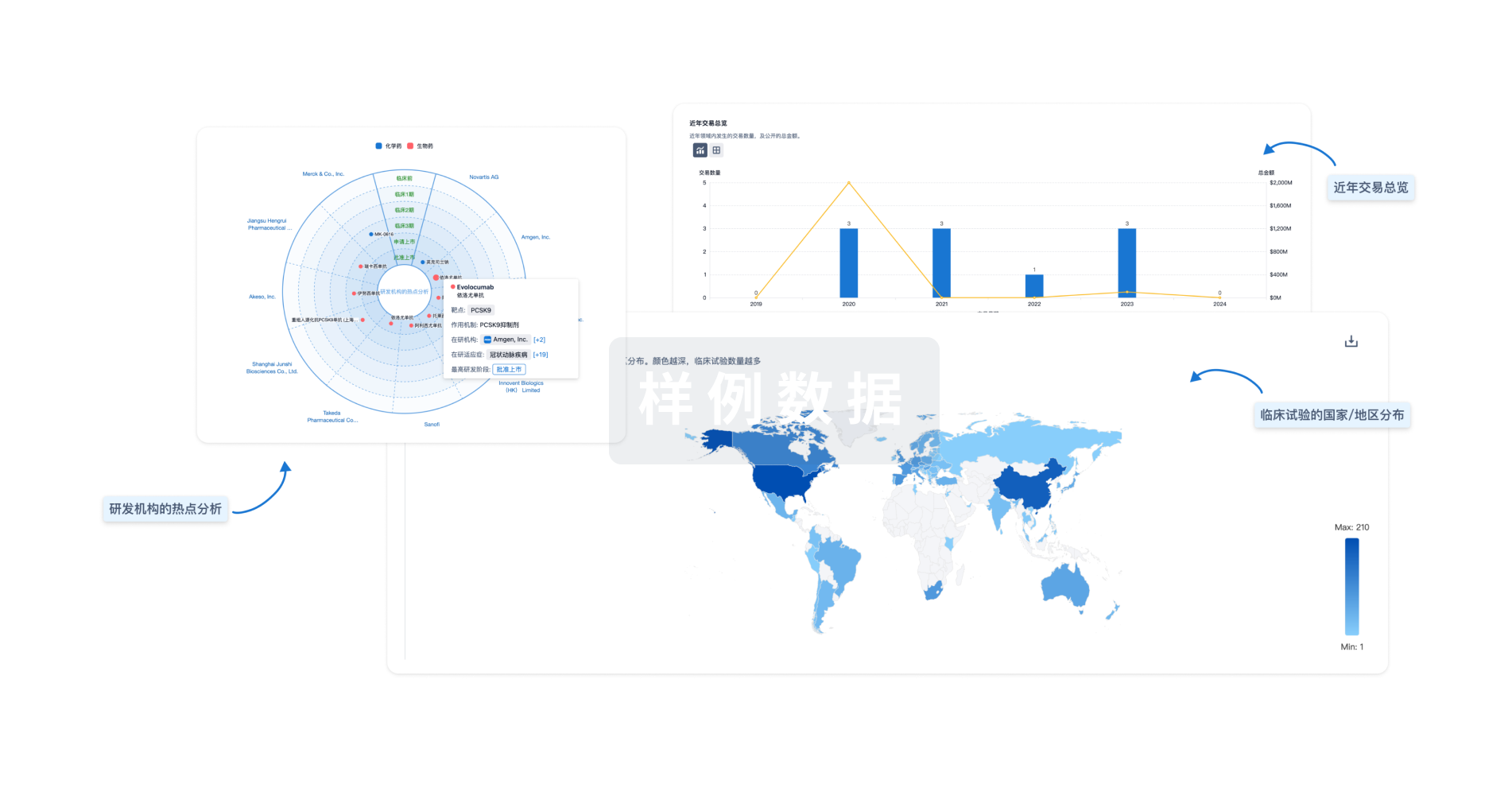预约演示
更新于:2025-05-07
MYOD1
更新于:2025-05-07
基本信息
别名 bHLHc1、Class C basic helix-loop-helix protein 1、Myf-3 + [7] |
简介 Acts as a transcriptional activator that promotes transcription of muscle-specific target genes and plays a role in muscle differentiation. Together with MYF5 and MYOG, co-occupies muscle-specific gene promoter core region during myogenesis. Induces fibroblasts to differentiate into myoblasts. Interacts with and is inhibited by the twist protein. This interaction probably involves the basic domains of both proteins (By similarity). |
关联
100 项与 MYOD1 相关的临床结果
登录后查看更多信息
100 项与 MYOD1 相关的转化医学
登录后查看更多信息
0 项与 MYOD1 相关的专利(医药)
登录后查看更多信息
5,463
项与 MYOD1 相关的文献(医药)2025-12-15·Animal Biotechnology
Relationship between the expression levels of myogenic regulatory factor genes and carcass characteristics in Kivircik and Hungarian Merino lambs
Article
作者: Kecici, Pembe Dilara ; Akyuz, Bilal ; Ozturk, Bekir ; Yalcintan, Hulya ; Daldaban, Fadime ; Ekiz, Bulent ; Arslan, Korhan
2025-10-01·Biomaterials
Hybrid cell membrane coating orchestrates foreign-body reactions, anti-adhesion, and pro-regeneration in abdominal wall reconstruction
Article
作者: Bi, Xuewei ; Zhang, Yilin ; Hou, Sen ; Yang, Lingbing ; Fan, Yubo ; Wang, Pu ; Li, Linhao ; Qian, Zhiyong ; Zhou, Jin
2025-05-01·Poultry Science
Dysfunctional terminal differentiation of satellite cells in the wooden breast muscle of Ross 308 broiler chickens
Article
作者: Wang, Xiaofei ; Zhang, Lin ; Zhao, Liang ; Zhu, Xudong ; Gao, Feng ; Wang, Xin ; Xing, Tong
17
项与 MYOD1 相关的新闻(医药)2025-01-25
·学术经纬
撰文|吴大荣 责编|周叶斌
癌症仍是儿童疾病死亡的主要原因。近年来为了开发更有效的治疗,对患有难治性或复发性儿童癌症患者的肿瘤组织开展了许多精准医学检测,以期找到可靶向的基因改变,但人们对肿瘤在诊断和复发之间是如何演变的了解很有限,分层医学儿科是英国精准医学计划,希望提供快速周转的临床级测序,并为复发或难治性患者提供临床报告。
分层医学儿科的一个明确目标是识别可能出现以下情况的患者:对分子靶向治疗药物作出反应;期望在癌症复发样品中发现基因组和表观遗传的决定因素;除临床计划外,还为组织样本和与时间匹配的血浆样本归档。
最近,英国伦敦癌症研究所小儿肿瘤实验医学中心 (POEM)的 路易斯·切斯勒(Dr. Louis Chesler)团队在 Cancer Discovery 上发表题为 Stratified Medicine Paediatrics: Cell free DNA and serial tumour sequencing identifies subtype specific cancer evolution and epigenetic states 的论文,利用大型且注释良好的侵袭性儿童恶性肿瘤基因组数据库,确定了儿童癌症复发的基因组和表观遗传驱动因素,并强调了游离细胞DNA(cfDNA)分析在捕捉肿瘤内异质性和癌细胞表观遗传状态方面的效力和实用性。
1. 与原发性匹对的复发性儿科肿瘤样本的基因组图谱
本文报告了与原发性匹对的复发样本中所发现的所有基因组改变的对比,41% 的序列改变同时存在于原发样本和复发样本中,而37% 仅在复发时发现(23% 仅在原发时发现)。所有参试人中,复发时最常改变的基因是 TP53(图 1a),在肉瘤患者中 TP53 突变的频率更高(图 1b)。在神经母细胞瘤中,复发时富集的最常见突变基因是ALK 和 NF1,应证了之前小型配对测序研究的结果 (图 1c)。除了复发时获得的ALK 突变外,ALK 也是诊断时最常见的突变基因,而ALK 突变仅在神经母细胞瘤中发现,显示了该基因在神经母细胞瘤发生和疾病进展中的突出作用。
图1. 与原发性匹对的复发样本中所发现的所有基因组改变的对比
复发时的小儿癌症显示出富集的表观遗传修饰因子突变
使用二代测序(NGS) 板块测序数据,计算同义突变与非同义突变的比率 (dN/dS) 以识别非同义变异和截断变异,假设这些变异是复发的驱动因子,发现复发时 DNA 高度富集在负责表观遗传修饰的基因突变上,包括 ATRX、SETD2、ARID1B 和 CREBBP(图 2),与表观遗传重塑作为儿童癌症治疗耐药性驱动因子的推断一致。
图2. 比较原发和复发时dN/dS 的比率,错义突变(红色)和截断突变(蓝色)
复发时高纯度 ctDNA 测序比组织测序能更好地反映肿瘤异质性
在所有测试人中(402 名患者),43% cfDNA 中检测到组织测序预期的改变,其中 89% 是预期的改变在高纯度样品中检测到,在低纯度样品中也检测到 25% 的预期变化。最常见的 cfDNA 独特变异是 ARID1A、NF1、PPM1D、TP53 和 CREBBP。在神经母细胞瘤中能检测到最高数量的 cfDNA 独特变异,与已知的神经母细胞瘤生物学中重要的表观遗传基因(ARID1A、ATRX、SMARCA4)和与超高危疾病相关的基因(ALK、NF1、PTPN11、FGFR1、TP53、ATM、CREBBP)一致。而且,当有足够的来自肿瘤的DNA(ctDNA)存在于循环系统(即cfDNA中ctDNA占比高)时,cfDNA测序比传统组织测序更好地反映了肿瘤异质性。
ctDNA能识别侵袭性亚克隆并可预测神经母细胞瘤的复发
例如,一名神经母细胞瘤患者的肾上腺肿瘤复发活检时未显示清晰的 CCND1 扩增,尽管确实显示了一些拷贝数变更(CNA) 表明肿瘤组织的存在,但复发时 cfDNA 的拷贝数谱有明显的CCND1 扩增,更符合与时间匹配时肝转移灶的活检(图3),这证明了 cfDNA 在检测神经母细胞瘤异质性方面的效用,包括检测出转移部位的遗传变化。另外,已知数据显示, TP53 和 RAS 通路突变在初诊和复发时与超高风险 (UHR) 神经母细胞瘤相关,但单次活检并不能完全捕获复发时肿瘤中存在的所有 UHR 突变,而这次大规摸试验表明了所有UHR 变异可以通过对肿瘤来源的游离 DNA 进行测序来检测。
图3. 神经母细胞瘤患者的拷贝数概况:原发组织(左上)和复发组织原发胸部部位的活检样本(左下)、复发时的 cfDNA 样本(右上)以及从某个部位收集的其他复发组织活检样本肝脏转移性病变(右下)
cfDNA 片段组学分析揭示癌症和组织特异性特征
鉴于儿童癌症的总体突变频率较低,需要确定ctDNA分析能否推断与起源组织和癌症特异性相关的其他表观遗传表达特征。为建立儿科肿瘤来源的 ctDNA 片段组学模式,研究人员应用 Griffin 方法,对比包含共有结合位点的基因转录调控(GTRD )数据库,使用 Wilcoxon 测试和层次聚类来识别转录因子结合位点,与其他肿瘤类型相比,分析一种肿瘤类型的可及性与差异。这一方法明确得出癌症特异性转录因子表达特征簇。对4个主要集群的基因本体富集分析,发现与起源细胞相关的基因组,包括神经母细胞瘤中的神经嵴衍生途径、神经母细胞瘤中的肌肉发育横纹肌肉瘤、淋巴瘤的免疫途径和肝细胞分化肝母细胞瘤簇。
这一方法还得到了与非霍奇金淋巴瘤 (NHL) 相关的最大簇,包含大量已知在 NHL 发病机制中发挥作用的转录因子,例如 BCL6、IRF4、BATF3、FOXO1 和BCL11A。在肾母细胞瘤患者中,只有一种转录的结合位点因子被确定为高度特异性和高度易感性:SIX2 一种已知的预后较差生物标记物和干细胞/胚细胞亚型相关转录因子。在肝细胞簇中,三中之二的转录因子为已知的具有肝细胞特异性因子。在包含MYOD1 和 MYOG的泛横纹肌肉瘤核心调节线路(CRC)中,横纹肌肉瘤样品显示明显的覆盖面积损失。在神经母细胞瘤样本中,确立了非甲肾上腺素的核心调节线路与其关键组成的转录因子, HAND2、ISL1、TBX2、GATA3 和 MYCN。综上所述, ctDNA 片段组学模式可识别与细胞起源和表观遗传可塑性有关的不同肿瘤特异性簇,这一发现在分析抗药性和复发特征时,对鉴别转录特征具有很大的潜力。
尽管本研究证明了 cfDNA 测序的附加价值,但值得注意的是,对于在相当大比例的患者中,肿瘤组织活检或 ctDNA 中均未检测到遗传改变复发的时间。这与其他研究一致,更证明了寻找儿科肿瘤侵袭性疾病的非遗传生物标记物的重要性。复发是由多种遗传机制驱动的,同一肿瘤,每个肿瘤细胞都相对罕见,因此如果没有较大的参测群体就很难检测到。表观遗传失调越来越多的被认为是侵袭性儿童癌症的主要驱动因素,而且转录回路在驱动高侵袭性疾病中表现出了特定的依赖性,这对于开发新的药物具有很高的价值。
本研究展示了儿科肿瘤诊断和复发之间的特定演变模式,包括识别肿瘤特异性和泛队列复发驱动因素。此外,cfDNA 的核体物分析不仅有可能识别儿科癌症的疾病亚型,还可以识别与疾病相关的表观遗传变化生物学。最后,本研究表明,对于复发性和难治性癌症患者,cfDNA 的标准临床级 lcWGS 可以用于推断癌细胞与起源细胞相关的表观遗传状态,并且具有连续和大规模应用的潜力,在应用中包括支持诊断、提供预后信息、识别新型疗法的表观遗传目标,以及连续采样了解新型疗法在改变表观遗传程序中的作用。
撰文
责编
制作
排版 | Sheila 校对 | uu
延伸阅读
绘制髓母细胞瘤基于神经递质受体的分子亚型特异性转录调控图谱
血浆游离DNA基因组分析确定新的霍奇金淋巴瘤亚型
常规全基因组测序(WGS):为疑似肿瘤儿童带来福音
*本文由深圳市拾玉儿童公益基金会“儿童肿瘤前沿”团队编译或约稿,文中图表均源引自文献原文。本文著作权归文章作者所有,欢迎个人转发分享,未经允许禁止转载,作者拥有所有法定权利,违者必究。如需转载,请留言或联系shiyu@curekids.cn。本文旨在分享儿童肿瘤科研前沿成果,不是治疗方案推荐。如需获得疾病治疗方案指导,请前往正规医院就诊。
▼滑动查看更多▼
原文摘要(Abstract)
We profiled a large heterogenous cohort of matched diagnostic-relapse tumour tissue and paired plasma-derived cell free DNA (cfDNA) from patients with relapsed and progressive solid tumours of childhood. Tissue and cfDNA sequencing results were concordant, with a wider spectrum of mutant alleles and higher degree of intra-tumour heterogeneity captured by the latter, if sufficient circulating tumour-derived DNA (ctDNA) was present. Serial tumour sequencing identified putative drivers of relapse, with alterations in epigenetic drivers being a common feature. In keeping with epigenetic alterations being a common driver of many childhood cancers, fragmentomics analysis of cfDNA identified tumour-specific epigenetic states and transcription factor binding sites accessible in chromatin. This study leverages a large and well-annotated genomic dataset of aggressive childhood malignancies, identifies genomic and epigenetic drivers of childhood cancer relapse, and highlights the power and practicality of cfDNA analysis to capture both intra-tumoural heterogeneity and the epigenetic state of cancer cells.
DOI: 10.1158/2159-8290.CD-24-0916
👇点击此处,直达原文
2025-01-20
·生物谷
本文中,小编整理了近期科学家们在干细胞研究领域取得的新成果,分享给大家!
【1】Nature:簇细胞在人体肠道中充当后备干细胞
doi:10.1038/s41586-024-07952-6
近日,一篇发表在国际杂志Nature上题为“Tuft cells act as regenerative stem cells in the human intestine”的研究报告中,来自胡布勒支研究所的研究人员利用实验室培育的微型人类肠道——肠道类器官,发现当免疫学线索触发肠道簇细胞(tuft cell)时,它们就会分裂制造新细胞。此外,与祖/干细胞不同的是,肠道簇细胞可以在严重损伤(如辐照损伤)后存活下来,并促进肠道上皮细胞的再生。这一发现可能对肠道组织受损后的再生具有重要意义。
Wnt和IL-4驱动簇细胞分化和增殖
图片来源:Nature, 2024, doi:10.1038/s41586-024-07952-6
人体肠道负责吸收营养和分泌激素。此外,它还保护肠道免受病原体的侵害。这些重要功能由肠道上皮组织中的特化细胞执行。肠道上皮由不同类型的特化上皮细胞组成,包括簇细胞。簇细胞遍布整个肠道以及许多其他器官。对这些细胞的功能和本体的了解大多来自对小鼠的研究。现有研究表明,有一类特殊的簇细胞能保护肠道免受病原体感染。当簇细胞感知到病原体的存在时,它们会向免疫细胞和肠道上皮细胞发出信号,启动强烈的防御反应。然而,由于缺乏人体研究模型,簇细胞在人体肠道中的功能一直不为人知。
这足以让作者利用他们开发的独特类器官技术深入探究这一问题。他们在一个培养皿中培育出微型肠道,模拟真实人类肠道的功能。这类称为类器官的结构包含所有不同类型的肠道细胞。研究者表示,我们利用这些类器官来仔细监测簇细胞的发育和功能。此外,这一模型还使我们能够研究辐射对这些类器官功能的影响。”
【2】Nature:新研究鉴定出调节神经干细胞衰老的基因
doi:10.1038/s41586-024-07972-2
人类大脑中的大多数神经元都会终生存在,这是有充分理由的。神经元突触之间复杂的结构关系中保存着错综复杂的长期信息。失去神经元就等于失去了这些关键信息,也就是遗忘。耐人寻味的是,在成体大脑中,一些新的神经元仍然由一个叫做神经干细胞的细胞群体产生。然而,随着年龄的增长,大脑越来越不善于制造这些新的神经元,这种趋势可能会对神经系统造成破坏性后果,不仅影响记忆力,还会影响阿尔茨海默病和帕金森病等退化性脑部疾病,以及中风或其他脑损伤后的恢复。
近日,一篇发表在国际杂志Nature上题为“CRISPR–Cas9 screens reveal regulators of ageing in neural stem cells”的研究报告中,来自斯坦福大学医学院的研究人员揭示了作为成体大脑中生成新神经元的细胞群体,神经干细胞如何以及为何随着年龄的增长而变得不那么活跃。这项研究还提出了一些有趣的后续步骤,通过靶向新发现的可以重新激活神经干细胞的途径,来解决年老的神经干细胞的钝态,甚至刺激需要修复的年轻大脑中的神经发生,即新神经元的产生。
研究者Anne Brunet博士和她的团队利用CRISPR平台(一种允许科学家精确编辑活细胞遗传密码的分子工具),在全基因组范围内寻找基因,当敲除这些基因时,可以提高来自老龄小鼠的体外培养样本中神经干细胞的激活,但不能提高来自年轻小鼠的体外培养样本中神经干细胞的激活。Brunet强调说,“我们首先发现了300个具有这种能力的基因,这已经很多了。”在将候选基因缩小到 10 个之后,“有一个基因特别引起了我们的注意”,Brunet说,“它是称为GLUT4蛋白的葡萄糖转运体的编码基因,这表明年老神经干细胞内和周围的葡萄糖水平升高可能使这些细胞处于不活跃状态”。
【3】Cell:利用合成组织者细胞诱导胚胎干细胞发育来再生和修复器官
doi:10.1016/j.cell.2024.11.017
近日,一篇发表在国际杂志Cell上题为“Synthetic organizer cells guide development via spatial and biochemical instructions”的研究报告中,来自西达赛奈医学中心和加州大学旧金山分校的研究人员发现了一种新的方法来传递指令,告诉小鼠胚胎干细胞(embryonic stem cell, ESC)生长成特定的身体结构,这是最终再生和修复组织和器官的关键步骤。
图片来源:Cell (2024) doi:10.1016/j.cell.2024.11.017
这些作者设计出形成特定身体结构的细胞,即合成组织者细胞(synthetic organizer cell)。这些组织者细胞通过称为形态发生素(morphogen)的生化信号向小鼠ESC提供指令,这些信号刺激并使得这些干细胞生长成特定的复杂组织和器官样组件。研究者Ophir Klein医学博士说,“我们可以利用这些合成组织者细胞来推动小鼠ESC制造早期胚胎的不同部分,或制造心脏或其他器官。”
在一个例子中,这些作者能够诱导小鼠ESC开始形成从头到尾延伸的小鼠身体,类似于子宫中的正常胚胎发育。在另一个例子中,他们能够刺激这些干细胞产生一种大型的心脏样结构,该结构具有一个中央腔室和一个有规律的跳动,以及一个早期血管网络。Wendell Lim博士说,“这种类型的合成组织者细胞平台提供了一种与小鼠ESC形成接口并对其发育进行编程的新方法。通过控制和重塑小鼠ESC分化和发育的方式,它可能使我们能够生长出更好的器官用于移植或用于疾病建模的类器官,并最终利用它来驱动活的患者体内的组织再生。”
【4】突破肌肉再生瓶颈!Nat Biotechnol:类器官培养促进小鼠成肌细胞去分化为肌肉再生的干细胞
doi:10.1038/s41587-024-02344-7
近日,哈佛大学Lee L. Rubin研究团队在Nat Biotechnol上发表了题为“Organoid culture promotes dedifferentiation of mouse myoblasts into stem cells capable of complete muscle regeneration”的研究论文,提出了一种从骨骼肌组织生成体外衍生卫星细胞(idSCs)的方法。研究结果表明,idSCs可能为治疗遗传性肌肉疾病、创伤引起的肌肉损伤和与年龄相关的肌肉无力提供可扩展的细胞来源。
研究表明,在三维培养条件下,肌母细胞可以逆转为卫星细胞样状态。卫星细胞通过表达转录因子Pax7来维持干细胞特性,而肌母细胞则通过激活MyoD进行分化并丧失干细胞潜能。将肌母细胞在旋转瓶中培养形成骨骼肌类器官(SkMOs),并调整培养条件,最终生成的SkMO细胞表现出肌球蛋白重链(MyHC)和Pax7的双重表达。
使用转基因小鼠,研究验证了SkMO中的GFP+细胞具有类似卫星细胞的特征,包括静止状态、小细胞体积和克隆生长能力。这些SkMO衍生的GFP+细胞能够形成克隆,并在体外分化为多核肌管。最终,这些细胞被称为idSCs,展示了其在三维培养中重塑为卫星细胞的能力。
【5】Science:新研究揭示DNA重复元件阻断造血干细胞吞噬机制
doi:10.1126/science.adn1629
造血干细胞和祖细胞(hematopoietic stem and progenitor cell, HSPC)一生都在制造成熟的血细胞。在此过程中,造血干细胞与骨髓壁龛中的多种细胞(包括巨噬细胞)相互作用。这些巨噬细胞通过释放细胞因子和趋化因子以及巡逻来清除遭受应激、死亡或老化的细胞,从而介导一系列过程。通过这种方式,巨噬细胞为维持组织稳态做出了贡献。
在造血过程中,巨噬细胞确保正常造血干细胞的质量,并决定参与成体造血的造血克隆的数量。然后,巨噬细胞要么完全吞噬干细胞(称为“吞噬”),要么捕获干细胞的部分细胞物质(称为 “梳理”)。梳理后的干细胞继续分裂,而注定死亡的 HSPC 克隆则被清除。过去的研究表明,HSPC与巨噬细胞的相互作用是由HSPC表面的“吃我”信号——钙网蛋白(calreticulin, Calr)介导的。活性氧(ROS)水平较高的造血干细胞表面Calr水平会升高,这会触发巨噬细胞吞噬并杀死含有大量应激激活蛋白的干细胞。然而,调节“吞噬”与 “梳理”行为的具体分子线索仍然未知。
在一项新的研究中,为了研究介导吞噬与梳理行为的线索,来自波士顿儿童医院和哈佛大学等研究机构的研究人员在人体细胞中筛选了 1200 种生物活性小分子,发现 93 种化合物能以剂量依赖的方式显著增加表面 CALR。在这些化合物中,22 种在斑马鱼中还促进了巨噬细胞与干细胞之间的相互作用。
依赖 ROS 增加 CALR 的化合物表现出更高的吞噬率,相反,用不依赖 ROS 的化合物处理的斑马鱼,尽管 CALR 增加,巨噬细胞与干细胞的相互作用增加,但发生梳理事件的概率更高。为了研究在不依赖 ROS 的条件下参与相互作用的信号,研究者在人类细胞中进行了一次全基因组筛选。他们发现 Toll 样受体 3 (TLR3) 是“别吃我”情况下的 CALR 诱导因子。
【6】Science子刊:新研究揭示毛囊干细胞的代谢灵活性导致鳞状细胞皮肤癌抵抗治疗
doi:10.1126/sciadv.adn280
近日,一篇发表在国际杂志Science Advances上题为“Defining metabolic flexibility in hair follicle stem cell induced squamous cell carcinoma”的研究报告中,来自加州大学洛杉矶分校伊莱和艾迪斯-布罗德再生医学与干细胞研究中心的研究人员发现了鳞状细胞皮肤癌用来抵抗治疗的关键代谢机制,为如何阻止癌症生长提供了新的见解。他们的研究结果强调了同时靶向多种代谢途径的综合疗法的必要性。这种方法不仅可能为在皮肤表面细胞中形成的鳞状细胞皮肤癌带来更有效的疗法,还可能为具有类似代谢特征的无数其他癌症带来更有效的疗法。
图片来源:Science Advances, 2024, doi:10.1126/sciadv.adn2806
2019 年,Lowry和他的同事们推翻了癌症代谢理论中称为瓦博格效应(Warburg effect)的基本学说,即癌细胞主要依靠葡萄糖获取能量。相反,他们发现鳞状细胞皮肤癌细胞的代谢具有灵活性:当无法获得葡萄糖时,它们可以转而从氨基酸谷氨酰胺中获取能量。Lowry说,“我们的数据表明,以前靶向癌症代谢的临床研究之所以失败,是因为它们一次只关注一条途径。在生物体内,肿瘤可以利用多种营养物质来促进其生长,因此针对单一途径的干预是不够的。”
基于此,Lowry实验室的研究生Carlos Galván一直在研究这种代谢灵活性的程度,以及是否可以抑制这种灵活性。他利用小鼠模型,从基因上阻断了谷氨酰胺为毛囊干细胞(已知是鳞状细胞皮肤癌的起源细胞类型)中的细胞提供燃料的途径,并观察了这对肿瘤形成和生长的影响。与之前的实验一样,肿瘤只是换用了另一种营养物质来源。
【7】Cell Rep Med:神经干细胞移植治疗或有望治疗人类的慢性脊髓损伤
doi:10.1016/j.xcrm.2024.101841
近日,一篇发表在国际杂志Cell Reports Medicine上题为“Long-term clinical and safety outcomes from a single-site phase 1 study of neural stem cell transplantation for chronic thoracic spinal cord injury”的研究报告中,来自加利福尼亚大学等机构的科学家们通过进行I期临床试验证明了神经干细胞移植治疗机体慢性脊髓损伤的长期安全性和可行性,慢性脊髓损伤这种毁灭性的机体损伤往往会大致机体部分或完全瘫痪,目前尚无有效的治愈手段。
这项研究中,研究人员对4名慢性脊髓损伤的患者进行了长达5年的随访,结果发现,2名患者在接受神经干细胞移植治疗后表现出了机体神经系统功能改善的持久证据,包括运动和感觉评分增加,肌电图(EMG,electromyography)活性得到了改善,一些患者机体的疼痛评分也有所改善。神经干细胞移植(neural stem cell transplantation)是一种新型的疗法,其能通过将人类机体衍生的干细胞植入到患者机体神经系统受损或疾病区域,从而来治疗多种神经系统疾病和损伤;由于这些神经干细胞来源于人类细胞,这种疗法或许有望再生机体受损的组织并能无缝整合到机体现有的神经系统中。
研究人员发现,所有4名患者对疗法的耐受性都较好,尽管当前研究只是为了评估疗法的安全性和耐受性,但实际上本文研究结果表明,神经干细胞移植疗法或许具有治疗机体慢性脊髓损伤的治疗性潜能,在这些有希望的研究结果之后,研究人员希望能启动II期临床试验来评估这种疗法的疗效。
【8】Nat Biotechnol:利用造血干细胞制造的异体CAR-iNKT细胞有望作为现成的细胞疗法治疗一系列癌症
doi:10.1038/s41587-024-02226-y
免疫疗法利用人体自身的免疫系统攻击癌细胞,阻止肿瘤生长,从而彻底改变了癌症治疗方法。然而,这些疗法往往需要根据每位患者的具体情况量身定制,从而减慢了治疗进程,导致每位患者的治疗费用高达数十万美元。
为了解决这些局限性,来自加州大学洛杉矶分校的研究人员在一项新的研究中开发出了一种新的临床指导方法,用于设计更强大的称为恒定自然杀伤细胞(invariant natural killer T cell, iNKT)的免疫细胞,可用于“现成的”癌症免疫疗法,即来自单一脐带血供体的免疫细胞可用于治疗多名患者。这一发现标志着向CAR-T细胞疗法等细胞疗法的大规模生产迈出了重要一步,使这些挽救生命的疗法更加经济实惠,更多患者可以接受。相关研究结果近期发表在Nature Biotechnology期刊上,论文标题为“Generation of allogeneic CAR-NKT cells from hematopoietic stem and progenitor cells using a clinically guided culture method”。
图片来源:Nature Biotechnology, 2024, doi:10.1038/s41587-024-02226-y
2021年,Yang团队报告了一种利用造血干细胞生产大量iNKT细胞的方法。该系统需要使用三维胸腺类器官和支持细胞,这给生产和监管带来了挑战,阻碍了该方法的临床应用。如今,他们开发出一种技术,能以无饲养细胞和无血清的方式利用造血干细胞产生大量iNKT细胞。这种方法上的升级消除了以前的障碍,使得他们比以往任何时候都更接近为患者提供 “现成的”癌症免疫疗法。
这些作者从15份代表不同遗传背景的捐献者脐带血样本中分离出造血干细胞,它们可以自我复制并产生各种血细胞和免疫细胞。据估计,一次脐带血捐献可产生1000到10000剂量的治疗药物,因此该系统非常适合制造“现成的”免疫疗法。
【9】Science:在怀孕期间和大量出血后,逆转录转座子激活造血干细胞,从而促进血细胞产生
doi:10.1126/science.ado6836
近日,一篇发表在国际杂志Science上题为“Retrotransposons are co-opted to activate hematopoietic stem cells and erythropoiesis”的研究报告中,来自德克萨斯大学西南医学中心的研究人员报告说,人类基因组中的古老病毒残余在怀孕期间和大量出血后被激活,以增加血细胞的生成,这是确定人类基因组中“垃圾DNA”用途的重要一步。
研究者Sean J. Morrison博士和论文第一作者Julia Phan博士着手探索通常很少分裂的造血干细胞在怀孕期间和失血后如何被激活。当他们比较怀孕小鼠和未怀孕小鼠体内造血干细胞中的激活基因时,发现怀孕小鼠体内的造血干细胞中的逆转录转座子已经开启。逆转录转座子是古老的病毒基因序列,如今已永久成为我们基因组的一部分,有时被称为 “垃圾DNA”,因为它们不编码有助于细胞功能的蛋白。它们使用一种叫做逆转录酶的酶进行自我复制,就像人类免疫缺陷病毒(HIV)一样。
人类已经进化出一种机制,让逆转录转座子在大多数情况下处于关闭状态,因为逆转录转座子在复制和重新插入到基因组其他部分中时有能力破坏DNA。Morrison博士说,“这与我们预期的情况相反。如果说有什么时候需要保护基因组的完整性并避免突变的话,那就是怀孕期间。我们的基因组中有数百个这样的逆转录转座子序列。为什么不像某些物种那样使它们永久失活呢?它们一定对我们有某种适应价值。”
【10】Science:揭示PIEZO离子通道依赖的机械传感对肠道干细胞的命运决定和维持至关重要
doi:10.1126/science.adj7615
近日,一篇发表在国际杂志Science上题为“PIEZO-dependent mechanosensing is essential for intestinal stem cell fate decision and maintenance”的研究报告中,来自多伦多病童医院和居里研究所的研究人员揭示了肠道干细胞如何感知环境并做出反应,对炎症性肠病和结直肠癌具有重要意义。
肠道干细胞壁龛的PIEZO 机械传感模型
图片来源:Science(2024) doi:10.1126/science.adj7615
肠道干细胞在化学信号和物理力量的作用下,不断适应环境,以维持器官和组织的健康。如果肠道干细胞不能发挥预期功能,就会导致一系列健康问题,包括炎症性肠病(IBD)和结直肠癌。迄今为止,肠道干细胞如何感知周围的物理力量仍不清楚,但由多伦多病童医院前博士后研究员Meryem Baghdadi博士、Tae-Hee Kim博士和居里研究所的Danijela Vignjevic博士领导的一个研究团队在这项新的研究中发现揭示,肠道干细胞的生存依赖于两个离子通道,即PIEZO1和PIEZO2。
Kim解释说,“肠道干细胞周围环境的物理特性对我们的健康至关重要。有了这些知识,我们就能探索促进胃肠道再生的方法,不仅能预防,还能修复受损的肠道干细胞。”(生物谷Bioon.com)
生物谷更多精彩盘点!敬请期待!
细胞疗法
2024-12-01
11月30日,广州医科大学与新疆石河子大学研究人员合作共同在期刊《Cell Death&Disease》上发表了研究论文,题为“GEFT inhibits the GSDM-mediated proptosis signalling pathway, promoting the progression and drug resistance of rhabdomyosarcoma”,在本研究中,研究人员发现NLRP3、caspase-1、caspase-3、GSDMD和GSDME在RMS中的表达明显低于骨骼肌组织。尼日菌素和放线菌素分别通过NLRP3/caspase-1/GSDMD通路和caspase-3/GSDME通路实现对RMS细胞焦亡的调控作用。MLKL药理抑制剂逆转尼日菌素诱导的细胞焦亡相关变化,siGSDME将放线菌素诱导的细胞焦亡转化为细胞凋亡。此外,GEFT抑制GSDMD和GSDME细胞焦亡通路,从而促进RMS的进展和耐药。小鼠异种移植和肿瘤分析证实,尼日菌素和放线菌素可通过激活细胞焦亡通路有效提高RMS的治疗效果。本研究是第一个聚焦于RMS细胞焦亡的研究。总之,本研究表明,尼日菌素和放线菌素通过促进RMS细胞焦亡在肿瘤中发挥治疗作用。干扰GEFT及联合用药对肿瘤有较好的抑制作用。
11月30日,广州医科大学与新疆石河子大学研究人员合作共同在期刊《Cell Death&Disease》上发表了研究论文,题为“GEFT inhibits the GSDM-mediated proptosis signalling pathway, promoting the progression and drug resistance of rhabdomyosarcoma”,在本研究中,研究人员发现NLRP3、caspase-1、caspase-3、GSDMD和GSDME在RMS中的表达明显低于骨骼肌组织。尼日菌素和放线菌素分别通过NLRP3/caspase-1/GSDMD通路和caspase-3/GSDME通路实现对RMS细胞焦亡的调控作用。MLKL药理抑制剂逆转尼日菌素诱导的细胞焦亡相关变化,siGSDME将放线菌素诱导的细胞焦亡转化为细胞凋亡。此外,GEFT抑制GSDMD和GSDME细胞焦亡通路,从而促进RMS的进展和耐药。小鼠异种移植和肿瘤分析证实,尼日菌素和放线菌素可通过激活细胞焦亡通路有效提高RMS的治疗效果。本研究是第一个聚焦于RMS细胞焦亡的研究。
总之,本研究表明,尼日菌素和放线菌素通过促进RMS细胞焦亡在肿瘤中发挥治疗作用。干扰GEFT及联合用药对肿瘤有较好的抑制作用。
https://www.nature.com/articles/s41419-024-07243-y
https://www.nature.com/articles/s41419-024-07243-y
背景知识
背景知识
01
01
横纹肌肉瘤(RMS)是儿童最常见的软组织肉瘤。尽管采取了综合治疗,高危RMS患者的5年总生存率仍为20 ~ 30%,预后较差。ARMS、myod1突变型SRMS、PRMS和tfcp2相关基因融合的RMS往往预后不良。从遗传学角度来看,RMS可能是融合阳性(FP)或融合阴性(FN)亚型。FP RMS与PAX3/7-FOXO1或EWSR1/FUS::TFCP2融合基因相关,FN RMS涉及信号通路,包括hedgehog、Notch和Wnt信号通路。表观遗传机制调控基因表达并促进RMS的发生发展。全基因组DNA甲基化研究报告了FP和FN RMS中DNA甲基化与突变变化和转录组织之间关系的证据。因此,RMS的发病机制涉及许多基因、信号通路和表观遗传学的改变,导致治疗效果不佳。
横纹肌肉瘤(RMS)是儿童最常见的软组织肉瘤。尽管采取了综合治疗,高危RMS患者的5年总生存率仍为20 ~ 30%,预后较差。ARMS、myod1突变型SRMS、PRMS和tfcp2相关基因融合的RMS往往预后不良。从遗传学角度来看,RMS可能是融合阳性(FP)或融合阴性(FN)亚型。FP RMS与PAX3/7-FOXO1或EWSR1/FUS::TFCP2融合基因相关,FN RMS涉及信号通路,包括hedgehog、Notch和Wnt信号通路。表观遗传机制调控基因表达并促进RMS的发生发展。全基因组DNA甲基化研究报告了FP和FN RMS中DNA甲基化与突变变化和转录组织之间关系的证据。因此,RMS的发病机制涉及许多基因、信号通路和表观遗传学的改变,导致治疗效果不佳。
细胞焦亡是由GSDM家族成员介导的一种新的程序性细胞死亡,在人类中包括GSDMA、 GSDMB、GSDMC、GSDMD、GSDME(也称为DFNA5)和PJVK(也称为DFNB59)。GSDMD和GSDME是两种最重要的细胞焦亡蛋白。GSDMD主要参与经典和非经典炎性小体焦亡通路。在前者中,病原体相关或损伤相关的分子模式刺激炎症小体,随后炎症小体激活caspase-1,参与IL-18前体和IL-1β前体的成熟。随后发生炎症反应和GSDMD裂解。GSDMD-N片段在细胞质膜上释放并形成孔隙,诱导细胞肿胀和渗透性溶解。在后者中,来自细菌的脂多糖识别并激活caspase-4/5/11,通过GSDMD裂解诱导细胞焦亡。细胞焦亡、坏死性凋亡和铁死亡被认为是影响癌症疗效的关键因素。然而,细胞焦亡在RMS进展中的作用尚不清楚。
细胞焦亡是由GSDM家族成员介导的一种新的程序性细胞死亡,在人类中包括GSDMA、 GSDMB、GSDMC、GSDMD、GSDME(也称为DFNA5)和PJVK(也称为DFNB59)。GSDMD和GSDME是两种最重要的细胞焦亡蛋白。GSDMD主要参与经典和非经典炎性小体焦亡通路。在前者中,病原体相关或损伤相关的分子模式刺激炎症小体,随后炎症小体激活caspase-1,参与IL-18前体和IL-1β前体的成熟。随后发生炎症反应和GSDMD裂解。GSDMD-N片段在细胞质膜上释放并形成孔隙,诱导细胞肿胀和渗透性溶解。在后者中,来自细菌的脂多糖识别并激活caspase-4/5/11,通过GSDMD裂解诱导细胞焦亡。细胞焦亡、坏死性凋亡和铁死亡被认为是影响癌症疗效的关键因素。然而,细胞焦亡在RMS进展中的作用尚不清楚。
NSA可部分逆转尼日菌素引起的细胞焦亡
NSA可部分逆转尼日菌素引起的细胞焦亡
02
02
为了探索潜在的机制,研究人员使用了GSDMD抑制剂NSA。NSA可直接与GSDMD结合而不影响GSDME,从而抑制p30-GSDMD孔形成和细胞焦亡。此外,NSA可通过抑制细胞焦亡和程序性坏死途径减轻肠道炎症,从而治疗炎症性肠病。研究人员分析了其对RMS细胞焦亡和生物学行为的影响。与尼日菌素单独处理相比,NSA+尼日菌素处理后RMS细胞GSDMD mRNA表达下调。GSDMD-N蛋白表达降低,NLRP3和cleaved caspase-1蛋白表达无变化。这些结果表明,抑制GSDMD后,细胞焦亡被部分抑制。
为了探索潜在的机制,研究人员使用了GSDMD抑制剂NSA。NSA可直接与GSDMD结合而不影响GSDME,从而抑制p30-GSDMD孔形成和细胞焦亡。此外,NSA可通过抑制细胞焦亡和程序性坏死途径减轻肠道炎症,从而治疗炎症性肠病。研究人员分析了其对RMS细胞焦亡和生物学行为的影响。与尼日菌素单独处理相比,NSA+尼日菌素处理后RMS细胞GSDMD mRNA表达下调。GSDMD-N蛋白表达降低,NLRP3和cleaved caspase-1蛋白表达无变化。这些结果表明,抑制GSDMD后,细胞焦亡被部分抑制。
NSA逆转尼日菌素引起的NLRP3/caspase-1/GSDMD经典细胞焦亡通路
NSA逆转尼日菌素引起的NLRP3/caspase-1/GSDMD经典细胞焦亡通路
研究人员进行了一系列细胞功能实验,以进一步了解GSDMD抑制是否影响RMS的生物学行为。研究表明抑制GSDMD可逆转尼日菌素诱导的RMS细胞焦亡相关变化,从而促进RMS细胞的增殖、侵袭和迁移能力。
研究人员进行了一系列细胞功能实验,以进一步了解GSDMD抑制是否影响RMS的生物学行为。研究表明抑制GSDMD可逆转尼日菌素诱导的RMS细胞焦亡相关变化,从而促进RMS细胞的增殖、侵袭和迁移能力。
GEFT-Rac1/Cdc42参与调控GSDMD和GSDME细胞焦亡信号通路
GEFT-Rac1/Cdc42参与调控GSDMD和GSDME细胞焦亡信号通路
03
03
研究人员对GEFT进行了筛选,发现GEFT与RMS的发生密切相关。分别用尼日菌素、放线菌素和siGEFT处理RD和RH30细胞,用GEFT稳定过表达,进一步明确GEFT与GSDMs信号通路的关系。过表达GEFT+尼日菌素组NLRP3、cleaved-caspase-1和GSDMD的mRNA和蛋白表达水平显著降低。此外,尼日菌素可抑制RMS细胞活力和增殖,GEFT可部分恢复这一现象,siGEFT与尼日菌素联合应用可显著抑制RMS细胞活力和增殖,促进RMS细胞死亡,具有较强的抑制作用。这些结果表明GEFT可以抑制尼日菌素诱导的细胞焦亡和细胞生物学行为的改变。初步研究表明GEFT可以直接结合Rac1和Cdc42抑制RMS的自噬和凋亡。研究人员进一步研究GEFT是否也通过Rac1/Cdc42影响细胞焦亡通路。用Rac1抑制剂NSC23766或Cdc42抑制剂ZCL278抑制Rac1/Cdc42后,GSDMD表达增加。以上结果提示GEFT-Rac1/Cdc42可通过调控GSDMD信号通路抑制RMS细胞焦亡及其生物学行为。GEFT可逆转药物诱导的细胞焦亡,干扰GEFT可增加药物敏感性。
研究人员对GEFT进行了筛选,发现GEFT与RMS的发生密切相关。分别用尼日菌素、放线菌素和siGEFT处理RD和RH30细胞,用GEFT稳定过表达,进一步明确GEFT与GSDMs信号通路的关系。过表达GEFT+尼日菌素组NLRP3、cleaved-caspase-1和GSDMD的mRNA和蛋白表达水平显著降低。此外,尼日菌素可抑制RMS细胞活力和增殖,GEFT可部分恢复这一现象,siGEFT与尼日菌素联合应用可显著抑制RMS细胞活力和增殖,促进RMS细胞死亡,具有较强的抑制作用。这些结果表明GEFT可以抑制尼日菌素诱导的细胞焦亡和细胞生物学行为的改变。初步研究表明GEFT可以直接结合Rac1和Cdc42抑制RMS的自噬和凋亡。研究人员进一步研究GEFT是否也通过Rac1/Cdc42影响细胞焦亡通路。用Rac1抑制剂NSC23766或Cdc42抑制剂ZCL278抑制Rac1/Cdc42后,GSDMD表达增加。以上结果提示GEFT-Rac1/Cdc42可通过调控GSDMD信号通路抑制RMS细胞焦亡及其生物学行为。GEFT可逆转药物诱导的细胞焦亡,干扰GEFT可增加药物敏感性。
过表达GEFT+放线菌素组Caspase-3 mRNA和蛋白表达及GSDME表达显著降低。放线菌素可以抑制RMS细胞的活力和增殖,GEFT可以部分恢复这一现象,siGEFT和放线菌素联合应用对细胞活力和增殖的抑制作用最显著,比单独应用放线菌素的作用更强。GEFT通过激活Rac1/Cdc42通路抑制GSDME焦亡通路。抑制GSDME不影响GEFT、Rac1和Cdc42的表达。以上结果提示GEFT- rac1 /Cdc42通过调控GSDME信号通路抑制RMS细胞焦亡,干扰GEFT可增加化疗药物的敏感性。
过表达GEFT+放线菌素组Caspase-3 mRNA和蛋白表达及GSDME表达显著降低。放线菌素可以抑制RMS细胞的活力和增殖,GEFT可以部分恢复这一现象,siGEFT和放线菌素联合应用对细胞活力和增殖的抑制作用最显著,比单独应用放线菌素的作用更强。GEFT通过激活Rac1/Cdc42通路抑制GSDME焦亡通路。抑制GSDME不影响GEFT、Rac1和Cdc42的表达。以上结果提示GEFT- rac1 /Cdc42通过调控GSDME信号通路抑制RMS细胞焦亡,干扰GEFT可增加化疗药物的敏感性。
结论
结论
04
04
综上所述,研究人员首次研究了RMS细胞焦亡的水平。研究人员证实,尼日菌素和放线菌素促进RMS细胞焦亡。 此外,与尼日菌素或放线菌素联合干扰GEFT可有效提高药物敏感性。(转化医学网360zhyx.com)
综上所述,研究人员首次研究了RMS细胞焦亡的水平。研究人员证实,尼日菌素和放线菌素促进RMS细胞焦亡。 此外,与尼日菌素或放线菌素联合干扰GEFT可有效提高药物敏感性。(转化医学网360zhyx.com)
【参考资料】
【参考资料】
https://www.nature.com/articles/s41419-024-07243-y
https://www.nature.com/articles/s41419-024-07243-y
【关于投稿】
【关于投稿】
转化医学网(360zhyx.com)是转化医学核心门户,旨在推动基础研究、临床诊疗和产业的发展,核心内容涵盖组学、检验、免疫、肿瘤、心血管、糖尿病等。如您有最新的研究内容发表,欢迎联系我们进行免费报道(公众号菜单栏-在线客服联系),我们的理念:内容创造价值,转化铸就未来!
转化医学网(360zhyx.com)是转化医学核心门户,旨在推动基础研究、临床诊疗和产业的发展,核心内容涵盖组学、检验、免疫、肿瘤、心血管、糖尿病等。如您有最新的研究内容发表,欢迎联系我们进行免费报道(公众号菜单栏-在线客服联系),我们的理念:内容创造价值,转化铸就未来!
转化医学网(360zhyx.com)发布的文章旨在介绍前沿医学研究进展,不能作为治疗方案使用;如需获得健康指导,请至正规医院就诊。
转化医学网(360zhyx.com)发布的文章旨在介绍前沿医学研究进展,不能作为治疗方案使用;如需获得健康指导,请至正规医院就诊。
细胞疗法临床研究临床结果临床1期
分析
对领域进行一次全面的分析。
登录
或

Eureka LS:
全新生物医药AI Agent 覆盖科研全链路,让突破性发现快人一步
立即开始免费试用!
智慧芽新药情报库是智慧芽专为生命科学人士构建的基于AI的创新药情报平台,助您全方位提升您的研发与决策效率。
立即开始数据试用!
智慧芽新药库数据也通过智慧芽数据服务平台,以API或者数据包形式对外开放,助您更加充分利用智慧芽新药情报信息。
生物序列数据库
生物药研发创新
免费使用
化学结构数据库
小分子化药研发创新
免费使用